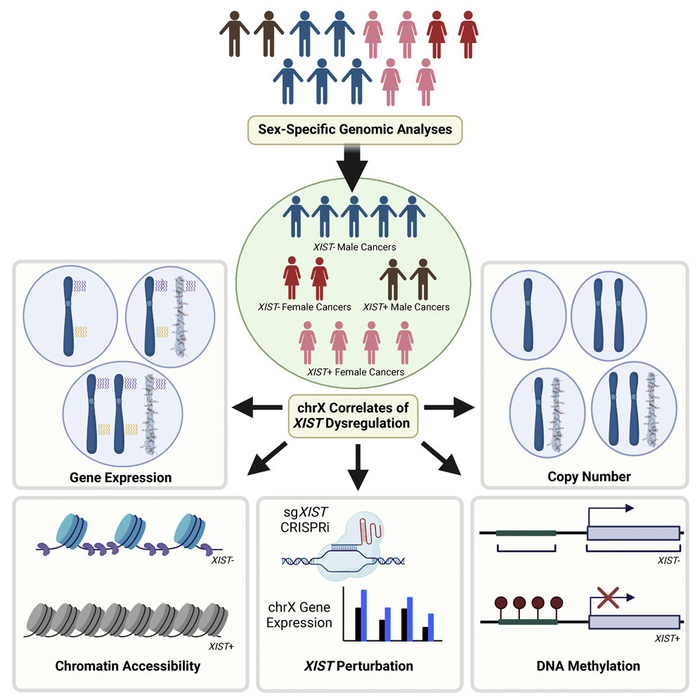Cancer cells acquire genetic anomalies that allow them to grow and proliferate unchecked. Researchers have now found another difference between cancer cells and normal cells: the X chromosome, typically only inactivated in XX female cells, can be inactivated across different male-derived cancers. This work is publishing November 9 in the journal Cell Systems.

Credit: Cell Systems/Sadagopan et al.
Cancer cells acquire genetic anomalies that allow them to grow and proliferate unchecked. Researchers have now found another difference between cancer cells and normal cells: the X chromosome, typically only inactivated in XX female cells, can be inactivated across different male-derived cancers. This work is publishing November 9 in the journal Cell Systems.
“To balance the expression of genes between the sexes, in normal development, one copy of the female X chromosome is inactivated at random across the human body. We wanted to know if this process that occurs in normal development goes awry in genetically unstable male or female cancer cells,” says senior author Srinivas Viswanathan (@srviswanathan), a cancer geneticist and medical oncologist at the Dana-Farber Cancer Institute.
By using publicly available datasets comprising of thousands of DNA samples from cancer patients around the world, the team of researchers stumbled upon the high expression of XIST—the gene responsible for shutting down gene expression on the X chromosome—in about 4% of the male cancer samples analyzed.
While XIST may be expressed in very early development in all sexes, X inactivation is thought to be a female-specific process later in development. It was previously shown that some female cancer cells may lose the ability to turn off one of the X chromosomes, leading to increased X-linked gene expression, but this ability of X inactivation had still only been studied primarily in female cells.
Within the 4% of anomalous male cancer samples identified, 74% were from reproductive cancers already shown to inactivate the X chromosome, but that left 26% of samples from other cancer types. These included liver, brain, skin, heart, lung, and thyroid cancers.
“We were very surprised by this result since XIST is a transcript typically used to classify female cancers, and so we wanted to ensure that this was not merely a result of mis-annotation. Yet, we do in fact see that some male cancers of diverse subtypes activate XIST and display features of X inactivation,” says Viswanathan.
“We have to be aware of the caveats of working with these types of datasets. These samples have been in many people’s hands, and there is more room for human error,” said co-corresponding author Cheng-Zhong Zhang, cancer biologist at the Dana-Farber Cancer Institute. “This is the biggest source of uncertainty for us; we have to be creative in how we look at the data and find controls.”
One possible explanation for why this phenomenon is occurring is genetic instability. Cancers often have multiple copies of chromosomes, and if two X chromosomes happen to be in one cell, then it may be necessary to inactivate one of them by activating XIST, regardless of whether that cell is in a female or male individual.
“Another possibility is there are some important genes on the X chromosome that, when silenced, enable the cancer to grow. We will investigate this in future studies,” says Viswanathan.
“In some ways, sex is the ultimate biomarker in that it subdivides the human population, but we often don’t think about how genetic differences between the sexes may inform cancer prognosis or response to therapy,” says Viswanathan.
###
Financial support provided by the Damon Runyon-Rachleff Innovation Award and institutional funds from Dana-Farber Cancer Institute, including the Claudia Adams Barr Program for Innovative Cancer Research. Information about conflicts of interest can be found in the text of the paper.
Cell Systems, Sadagopan et al. “Somatic XIST activation and features of X chromosome inactivation in male human cancers” https://www.cell.com/cell-systems/fulltext/S2405-4712(22)00403-3
Cell Systems (@CellSystemsCP) is a monthly journal published by Cell Press devoted to systems biology. Cell Systems papers use approaches from physics, engineering, mathematics, and computer science to address salient biological questions. Visit http://www.cell.com/cell-systems. To receive Cell Press media alerts, contact [email protected].
Journal
Cell Systems
DOI
10.1016/j.cels.2022.10.002
Method of Research
Meta-analysis
Subject of Research
Human tissue samples
Article Title
Somatic XIST activation and features of X chromosome inactivation in male human cancers
Article Publication Date
9-Nov-2022




